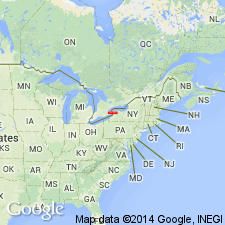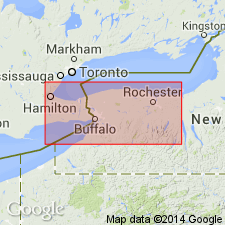
- Usage in publication:
-
- Merritton Limestone Member
- Modifications:
-
- Named
- Dominant lithology:
-
- Limestone
- Shale
- AAPG geologic province:
-
- Appalachian basin
Summary:
Named the Merritton Limestone Member of the Reynales Limestone in Ontario, CAN for village of Merritton. Consists of buff, brown, or gray, thin-bedded, argillaceous limestone with shale partings. Thickness is 1 m. Disconformably overlies the Neahga Shale, Thorold Sandstone, and Cabot Head Shale, and underlies the Rockway Dolomite Member of the Irondequoit Formation. The Merritton is of Silurian age.
Source: GNU records (USGS DDS-6; Reston GNULEX).

- Usage in publication:
-
- Merritton Limestone*
- Modifications:
-
- Overview
- AAPG geologic province:
-
- Appalachian basin
Summary:
The Merritton Limestone of the Clinton Group in the subsurface of western NY consists of light-greenish-gray, buff-weathering dolomitic to argillaceous limestone with thin shale partings. A black, phosphate-stained hardground typically separates the lower and middle beds. The limestone contains abundant bright-green glauconite and pyrite, particularly in basal 6 inches, which also contains sand- and gravel-sized phosphate nodules and chert pebbles. The lower two beds are fine-grained wackestone and the upper bed is coarser and contains abundant brachiopods (PENTAMEROIDES SUBERECTUS) and crinoidal debris. The Merritton averages 2.5 ft thick in type area and is only found in the subsurface in western NY where it is 0.5 ft thick. Unconformably overlies the Reynales Limestone, Neahga Shale (Clinton Group), and eventually the Thorold Sandstone (Medina Group); unconformably underlies the Williamson Shale or Rockway Dolomite (Clinton Group). The lower contact of the Merritton separates the lower and upper parts of the Clinton Group. East of the type section, unit is not present in outcrops and has not been identified in the Niagara Gorge section; however, a featheredge of the unit could be present in two drill cores. The Merritton is of Early Silurian (Llandoverian) age. [Report uses Early and Late Silurian time scale of Harland and others (1982).]
Source: GNU records (USGS DDS-6; Reston GNULEX).
For more information, please contact Nancy Stamm, Geologic Names Committee Secretary.
Asterisk (*) indicates published by U.S. Geological Survey authors.
"No current usage" (†) implies that a name has been abandoned or has fallen into disuse. Former usage and, if known, replacement name given in parentheses ( ).
Slash (/) indicates name conflicts with nomenclatural guidelines (CSN, 1933; ACSN, 1961, 1970; NACSN, 1983, 2005, 2021). May be explained within brackets ([ ]).

